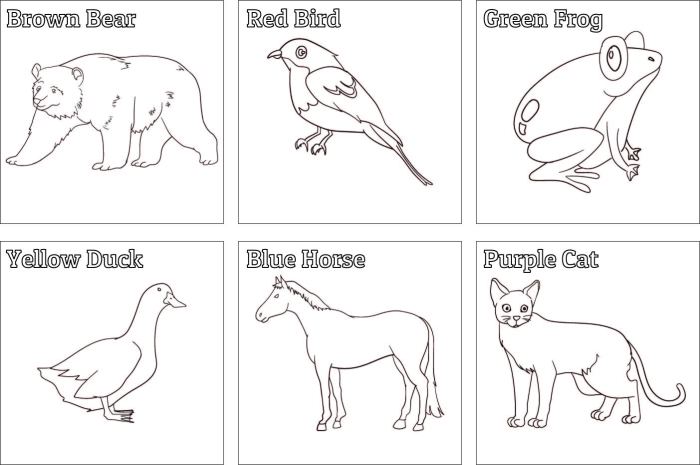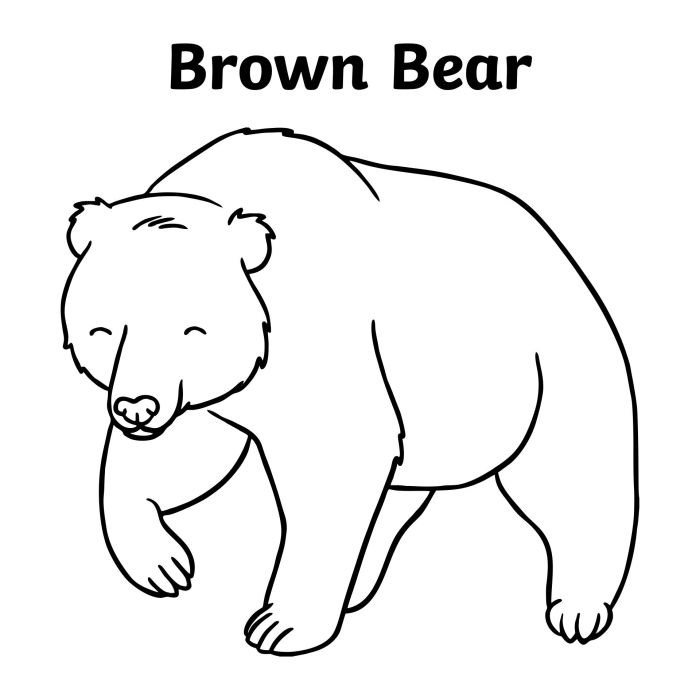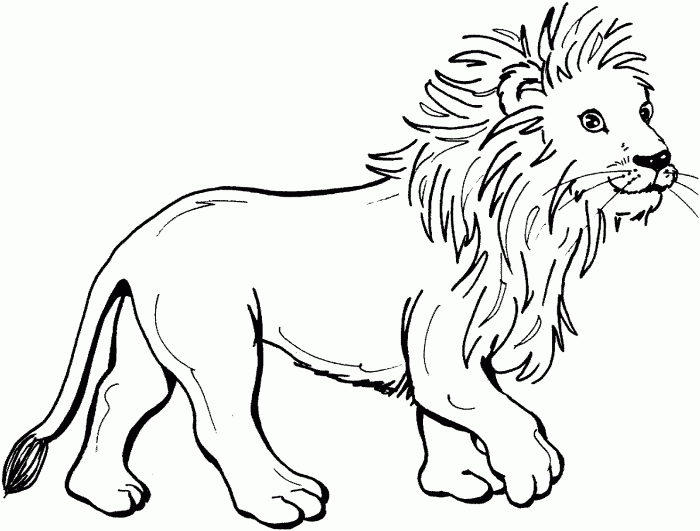Target Audience Analysis: Brown Bear Coloring Book

Understanding the target audience is crucial for creating a successful brown bear coloring book. Different age groups have varying preferences regarding coloring book style, complexity, and thematic elements. By tailoring the design to specific age ranges, we can maximize engagement and appeal.This analysis identifies the primary age groups likely to interact with a brown bear coloring book and details their preferences.
We will examine the characteristics of each group to inform design choices such as image complexity, color palettes, and overall aesthetic.
Age Range: 2-4 Years
This age group is characterized by a developing fine motor skills and a short attention span. They are drawn to bright, bold colors and simple, easily recognizable images. Their interest in brown bears would likely stem from their familiarity with the animal through children’s books and television shows. The preferred coloring book style would be predominantly cartoonish, with large, simplified shapes and minimal detail.
Examples include large, round shapes for the bear’s body, with simple lines for features like eyes, nose, and mouth. The color palette should feature primary colors and bright, contrasting shades.
Age Range: 5-7 Years
Children in this age group are refining their fine motor skills and are capable of handling more intricate designs. Their interests are broadening, and they are more receptive to detailed illustrations. While a cartoonish style can still be appealing, a slightly more realistic depiction of a brown bear might be suitable. The coloring pages could incorporate more detail, such as fur texture or environmental elements like trees and flowers.
The color palette can expand to include secondary and tertiary colors, allowing for more nuanced coloring. For example, a coloring page might show a brown bear fishing in a stream, with detailed depictions of the fish and the surrounding nature.
Age Range: 8-10 Years
This older age group demonstrates a greater level of artistic skill and patience. They are capable of handling complex designs and appreciate realistic details. A more realistic portrayal of a brown bear in its natural habitat would be highly appealing. The coloring pages can incorporate intricate details such as fur texture, muscle definition, and environmental elements. The color palette can be sophisticated, utilizing a wide range of shades and tones.
A coloring page depicting a brown bear hunting salmon in a rushing river, with detailed textures in the water and fur, would be an example of an appropriate level of complexity for this age group.
Design Concepts
Three distinct design concepts have been developed for the brown bear coloring book pages, catering to different skill levels and artistic preferences within the target audience. Each concept balances engaging visuals with age-appropriate complexity, ensuring a positive and enriching coloring experience. The design choices are informed by research on children’s preferences for coloring book imagery and color palettes.
Design Concept 1: Simple Shapes and Bold Lines
This concept focuses on creating easily colorable pages suitable for younger children (ages 3-5). The designs feature large, simplified shapes representing a brown bear. Visual elements are limited to basic forms like circles, ovals, and rectangles, combined to create a recognizable bear silhouette. Details are minimized to avoid overwhelming younger colorists.The color palette is bright and primary, consisting of browns, yellows, oranges, and greens.
Brown bear coloring books offer a wonderful opportunity to explore the rich textures and hues of these magnificent creatures. For a different seasonal approach, consider the vibrant designs found in a jack o lantern coloring book , which provides a striking contrast. Returning to brown bears, the calm focus required for coloring can be equally therapeutic, whether depicting a playful cub or a majestic adult.
These colors are vibrant and easy for children to identify and associate with a bear’s natural habitat. The bold Artikels ensure that children can easily stay within the lines, fostering a sense of accomplishment and improving fine motor skills. The simplicity of the design allows young children to focus on the process of coloring and expressing their creativity without the frustration of intricate details.
Design Concept 2: Moderate Detail and Naturalistic Style
This concept targets children aged 6-8, offering a balance between simplicity and complexity. The bear illustrations incorporate more detailed features, such as fur texture, individual claws, and expressive eyes, but still maintain a clear and easily colorable structure. The designs aim for a semi-realistic representation of a brown bear in its natural environment, possibly including elements like trees, flowers, or a stream.The color palette expands to include earth tones and muted shades, alongside brighter accents.
Examples include various shades of brown, beige, green, and blue, with pops of warmer colors like orange or yellow to highlight specific areas. This palette reflects the natural colors of a bear’s environment, providing an opportunity for children to explore subtle variations in shading and color mixing. The moderate level of detail encourages creativity and allows for more nuanced coloring techniques.
Design Concept 3: Intricate Details and Environmental Setting
This concept is designed for older children (ages 9-12) who are more comfortable with intricate designs. The illustrations feature a highly detailed brown bear, potentially showcasing a specific bear behavior or interaction within a rich environmental setting. The level of detail includes textured fur, realistic facial features, and a complex background with numerous elements, such as foliage, rocks, and other wildlife.The color palette is richer and more varied, incorporating a wide range of earth tones, cool blues, and greens to depict the natural environment.
The use of shading and highlighting techniques can create depth and realism. This encourages older children to experiment with different coloring techniques, such as layering, blending, and creating gradients. The intricate nature of the design allows for greater creative expression and the development of more advanced coloring skills. This concept provides a challenge for older children while still maintaining the appeal of the brown bear theme.
Page Layout and Structure

Effective page layout is crucial for a successful coloring book, ensuring both engagement and ease of use for the target audience. A well-designed page will guide the child’s coloring experience, promoting creativity and preventing frustration. Consideration must be given to the age range, as younger children require simpler layouts while older children can handle more complex designs.The layout should be visually appealing and uncluttered, allowing ample space for coloring without feeling cramped.
Careful placement of elements ensures a balanced and harmonious aesthetic. White space, or negative space, plays a vital role in creating a sense of breathing room and preventing visual overload.
Sample Page Layout Using a Table, Brown bear coloring book
The following example uses an HTML table to structure a sample page. This approach allows for responsive design, adapting well to different screen sizes.
 |
|
|
Fun Fact: Brown bears are excellent swimmers! |
Coloring Tip: Try using different shades of brown to create depth and texture. |
|
Color the bear and the surrounding forest scene. Use your imagination! |
|
The table’s first row contains a large image of a brown bear, perhaps situated in a forest setting. The illustration dominates the page, providing the primary focus for coloring. The second row is divided into two columns. The left column features a fun fact about brown bears, adding an educational element and engaging the child’s interest beyond the coloring activity itself.
The right column offers a coloring tip, providing guidance on technique and encouraging creative exploration. The final row provides a simple instruction to the child, encouraging imaginative coloring and free expression.
Page Layouts for Different Age Groups
Different age groups require varying levels of complexity in page design. Simpler layouts are more suitable for younger children, while older children can handle more intricate designs.Preschool (Ages 3-5): Pages should feature large, simple shapes and Artikels with minimal detail. The use of bold lines and easily identifiable objects ensures ease of coloring and prevents frustration. Large areas of color are preferred, promoting large motor skill development.
For example, a page might feature a single large brown bear with clearly defined sections for coloring.Early Elementary (Ages 6-8): More detailed illustrations can be introduced, incorporating smaller shapes and textures. The introduction of finer lines and more complex patterns encourages finer motor skill development. The inclusion of simple background elements adds visual interest without overwhelming the main subject.
A page might show a brown bear playing in a forest clearing, with trees, flowers, and other details to color.Late Elementary/Middle School (Ages 9-12): Complex illustrations and intricate designs are appropriate for this age group. The focus shifts towards more detailed rendering and the incorporation of shading and texture. More challenging patterns and designs can be incorporated to challenge and engage older children.
A page might depict a realistic brown bear in its natural habitat, with a detailed background and a wide range of textures and patterns to color.
Marketing and Branding
Effective marketing and branding are crucial for the success of the brown bear coloring book. A strong brand identity will help it stand out in a crowded market and appeal to its target audience of parents and educators. This section Artikels a proposed brand name, tagline, visual style, and marketing strategy.A carefully considered brand identity will be key to the book’s success.
This includes choosing a memorable name and tagline that reflect the book’s content and target audience, and developing a consistent visual style across all marketing materials. A robust marketing strategy will then ensure the book reaches its intended audience.
Brand Name and Tagline
The proposed brand name is “Bearly Believable Adventures.” This name is playful, memorable, and directly relates to the book’s content. It evokes a sense of wonder and excitement, appealing to children while also being easily understood by adults. The tagline is “Color Your Way to the Wild!” This tagline is concise, action-oriented, and highlights the creative and engaging nature of the coloring book.
It emphasizes the imaginative journey children will embark on while coloring the pages.
Visual Style and Tone
The overall visual style of the branding will be warm, inviting, and whimsical. The color palette will feature earthy tones like browns, greens, and yellows, reflecting the natural habitat of brown bears. Illustrations on the book cover and marketing materials will feature friendly, expressive brown bears engaging in various activities in a charming, child-friendly style. The font will be playful and easy to read, reflecting the book’s target audience.
The overall tone will be positive, fun, and engaging, aiming to create a sense of adventure and excitement. For example, the cover art might depict a brown bear cub playfully splashing in a stream, surrounded by lush greenery.
Marketing Strategy Targeting Parents and Educators
The marketing strategy will focus on reaching parents and educators through various channels. Online marketing will include targeted advertising on social media platforms like Facebook and Instagram, focusing on parenting and education groups. The book will also be promoted through collaborations with parenting blogs and educational websites. Offline marketing will involve partnerships with bookstores, libraries, and educational institutions.
Promotional materials will highlight the educational benefits of coloring, such as developing fine motor skills and fostering creativity. The marketing materials will also emphasize the high-quality printing and durable pages, assuring parents and educators of the book’s longevity. For instance, a sample page could be offered as a free printable download from the website, providing a taste of the book’s quality and engaging illustrations.
Additionally, educational resources, like coloring tips or fun facts about brown bears, could be provided online to further engage parents and educators.



